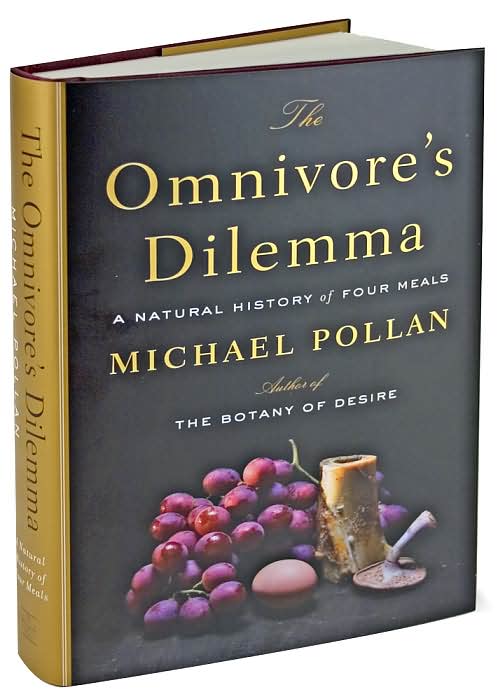 I'm about 1/3 of the way through Michael Pollan's The Ominivore's Dilemma. Pollan is a journalism professor at Cal and writes on food and the food industry.
I'm about 1/3 of the way through Michael Pollan's The Ominivore's Dilemma. Pollan is a journalism professor at Cal and writes on food and the food industry. You may have seen his cover article Unhappy Meals in the NYT magazine a couple months ago in which he argued that America's obsession with nutrition and convenience foods has made us fatter and more unhealthy, and that we should return to eating traditional food-- fruits, veggies, meats. No more vitamin water, power bars or other highly processed foods that are fortified with vitamins and nutrients. In short, he advocates for eating stuff our great, great grandparents would recognize.
I liked the article, so Mr. Octopus picked up The Ominivore's Dilemma for me. I've been reading it most nights before I go to bed. The first part of the book focuses on corn. Apparently corn is in everything. This I did not know. Here's what I learned (and can remember offhand).
Prior to WWII, farmers used to grow corn the way they grew everything else-- they would rotate it with other crops so as not to deplete the soil. So we had corn, but not tons of it. After WWII, we had a surplus of ammonium nitrate from munitions and had to find something to do with it. Scientists found a way to use ammonium nitrate/nitrogen to make chemical fertilizer and the industrialization of corn was born. As a result, farmers were able to grow corn year after year without ruining the soil. Suddenly we had more corn than we knew what to do with.
Today corn is in coke, ketchup, mustard, cereal and a gazillion other things-- thanks to high fructose corn syrup. It's in those strange ingredients on food labels-- fructose, dextrose, sucrose, xanthan gum. It's even used in the beef we eat. Cows have evolved to eat grass, but because corn is more plentiful we've started forcing it on cows, which in turn means we have to give cows antibiotics to process the corn. It just ain't natural.
According to Pollan, this surplus of corn has led to an overall increase in the amount of food available. And because corn is so cheap, consumers are able to get much more food for not much more money (this is why the supersize at McD's isn't much more expensive than regular). So we're taking in more calories without getting much more nutritional value. The result: a lot of overweight and obese people.
So that's corn, according to Michael Pollan. The second part of the book is about organic food, which (as far as I've read) is also a huge industry not without its faults. Supposedly he rips on Whole Foods. I'm curious about that.
Sidenote: Recently the CEO of Whole Foods came to Cal to speak with Pollan and defend his company's practices. I'm sure it was a lively discussion. It must be on the web somewhere. For a short article by Pollan, click here.

6 comments:
I loved his NY Times magazine story, I've been meaning to pick up a copy of the book too. Very interesting corn trivia.
I found out about corn thing about 10 years ago when reading about farm subsidies. It was pretty weird. We "try" to avoid as High fructose as much as possible.
And the thing about Whole Foods - it seems odd that one of the few largest organic retailers is getting slack. It's like you have to be 100% natural, down to using candles and selling food off the back of a used bike, for everything or you're not "real".
Quite beyond the Mayan's wildest imagination, corn is quite literally everywhere:
http://www.commondreams.org/archive/2007/03/27/109/
Recall also my comments on your post regarding biodiesel several months ago.
My previous post on biodiesel here. I still agree that it's got to be used veggie oil, not ethanol. The corn lobby sure is powerful.
... so powerful that Bush and Lula just signed a biodiesel accord for Brazilian produced biodiesel. Bye-bye Amazon rainforests.
I read about this recently in an article that projected the price of everything will go up thanks to this lame-brained ethanol idea. Ethanol requires vast amounts of corn, which will take corn away from all the food products you mentioned, making them more expensive. It predicted a gallon of milk will be $4.00 by the end of the year. (currently, it's 2.99-3.55 depending if it's on sale).
Post a Comment